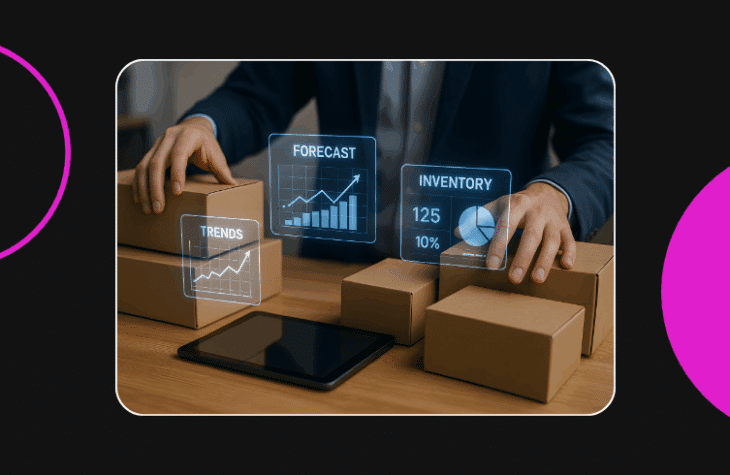A Retail Operations Executive’s Guide to Scaling Shopify With fabric

Millions of merchants worldwide use Shopify to power their omnichannel retail operations. It’s a ubiquitous commerce platform that helps merchants sell online, in-store, and across social media and marketplaces. However, as operational complexity increases due to growing product catalogs, expanded logistics options, and dropshipping, growing retailers require additional capabilities to ensure growth continues.
fabric extends Shopify through a modern, API-first Order Management System (OMS) so you can keep your foot on the accelerator.
Read on to understand where retail complexities cause omnichannel hassles, how fabric adds control and flexibility to bridge gaps, and why it’s crucial to augment Shopify’s capabilities before growth suffers.
Even modest retail operations on Shopify need more control and flexibility
Shopify continues to redefine retail. Its growth seems limitless as it pushes toward $3 billion in revenue and expands into new markets like taxes and B2B commerce.
However, expanding commerce brings fulfillment complexity for omnichannel retailers looking to drive that same hockey-stick trajectory. For fast-moving merchants, your need for speed requires flexibility and control.
For example, as your retail operation grows, it’s natural for SKUs to balloon as more sizes, styles, colors, and options are used to win over more customers. Product catalogs get messy with new versions and categories, leading to multi-level taxonomies and collections. Inventories grow across channels, options for pre-orders add complexity, and allocation rules vary across regions.
As your business expands into new categories, markets, and regions, you need new logistics partners to streamline fulfillment while dropshippers add more growth opportunities. But, complexity increases as pre-orders and backorders pile up and cancellations cause reallocations that overwhelm fulfillment automation rules.
Almost overnight, even a small retail operation surpasses the limits of Shopify’s leading retail platform. All it takes is adding a physical location, opening a distribution center, or working to increase efficiencies.
But you do have options.
How fabric extends Shopify’s capabilities
Retail success depends on customer demand. However, if the retailer fails to turn the clicks of demand into delivered products and happy customers, that demand will quickly wane.
fabric connects demand with complex fulfillment with a unified view of inventory, automated insights for optimal logistics, and flexible fulfillment options that drive efficiency and speed–all integrated across Shopify and other selling, fulfillment, and back office tools.
We’ve built fabric as a modern, API-first OMS that brings:
1. Inventory visibility across storefronts and channels
Workarounds and physical allocations are the only ways to align inventory with storefronts when inventory is tied to different locations or Shopify instances. fabric integrates with Shopify seamlessly to create a single, centralized source of truth that automatically allocates inventory in real-time and updates availability across channels, with zero manual effort. Your customers get a better experience, and you know exactly what’s available to sell, so you never oversell or miss a customer’s buy.
2. Smart order routing with AI-driven fulfillment
More stores and facilities mean more options for fulfillment, but it can be challenging to enable automated location selections and logistics on Shopify beyond distance considerations. fabric provides a highly configurable and intelligent order routing to balance network capacity and ship items from optimal locations based on preferences, costs, speed, or other unique parameters. fabric AI adds intelligent fulfillment orchestration that complements Shopify’s built-in logic while providing more visibility. Your customers get their orders faster, and you see fulfillment costs drop.
3. Easy pre-orders and backorders with fewer split shipments
Shopify has over 16,000 apps in its thriving app store, which adds complexity, maintenance, and adoption challenges for expected capabilities like support for pre-orders, backorders, and line-level BOPIS. Without custom logic and third-party app configurations, customer experience suffers, and stacked shipping fees add to their frustrations. fabric adds pre-orders and backorders out-of-the-box for Shopify customers, with intelligent and flexible inventory management and optimized shipping that avoids the excess fees of split shipments and lets customers choose to pick up or ship items. These pre-order and backorder capabilities enable true endless aisle strategies, letting customers purchase items beyond in-store or on-hand availability. Backorders, in particular, give retailers the ability to save the sale on evergreen products that are in transit, shipping them once back in stock. Your customers gain more choice and flexibility while you get granular controls to reduce fulfillment costs and delight customers.
Solve your OMS challenges before they slow your growth
Shopify’s success in empowering merchants is unmatched. As your retail operations grow, it’s a sure bet that Shopify is a solid foundation for the long haul. However, shifting customer expectations, advancing technologies, and omnichannel complexities are today’s reality, and fabric is here to help remove the friction from your growth objectives.
fabric enhances Shopify’s power with more control, more flexibility, and more visibility where you need it most–and where customers expect it most. Working alongside Shopify via our API-first OMS, fabric puts you in control to orchestrate inventory, fulfillment, and the customer experience as you scale.
Don’t let platform challenges hold you back. When a rock-solid retail foundation is what you need, Shopify is the best choice. But when omnichannel complexity threatens your growth, fabric gives modern brands like yours the speed, flexibility, and control needed to keep the pedal to the metal.
Contact us today to learn more about fabric.

Digital content editorial team @ fabric





